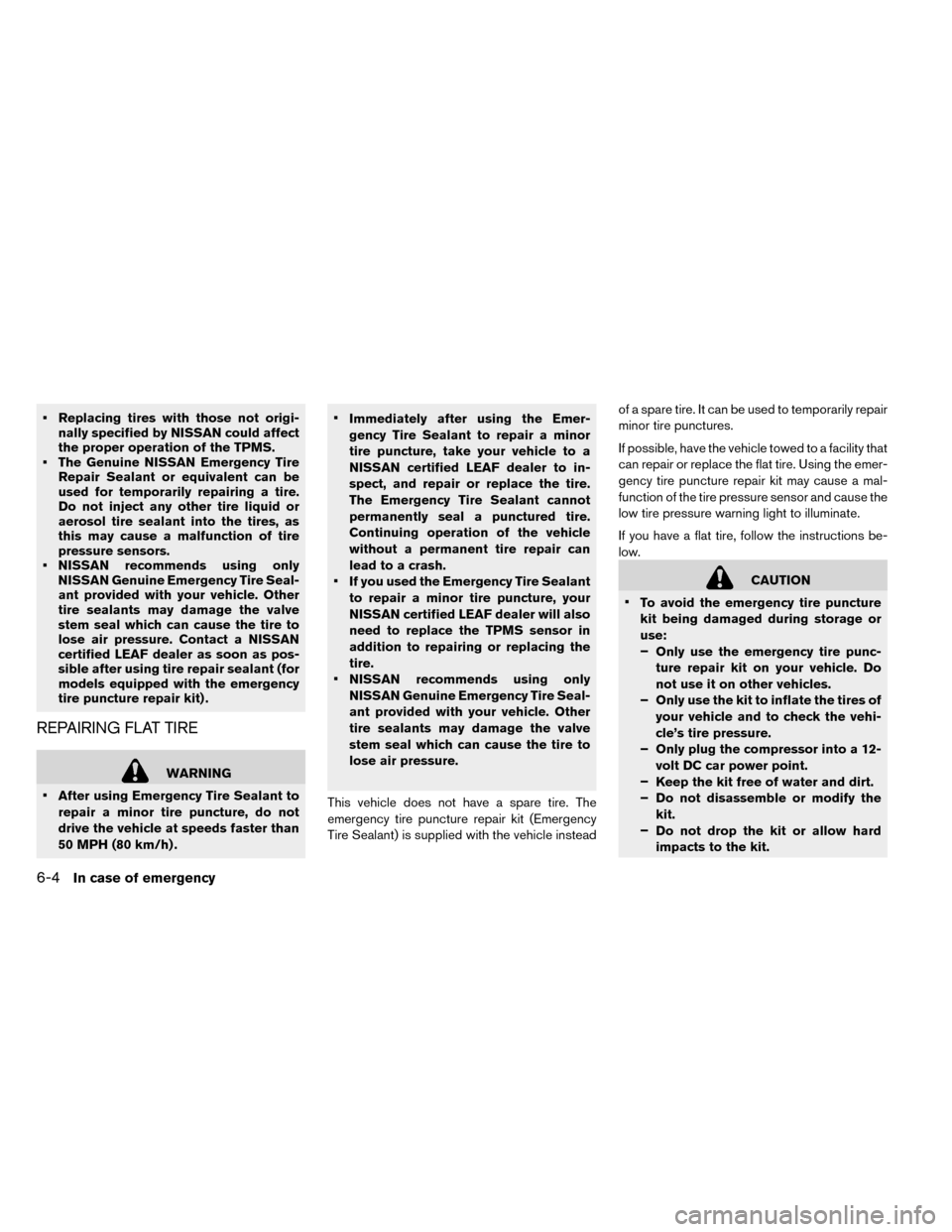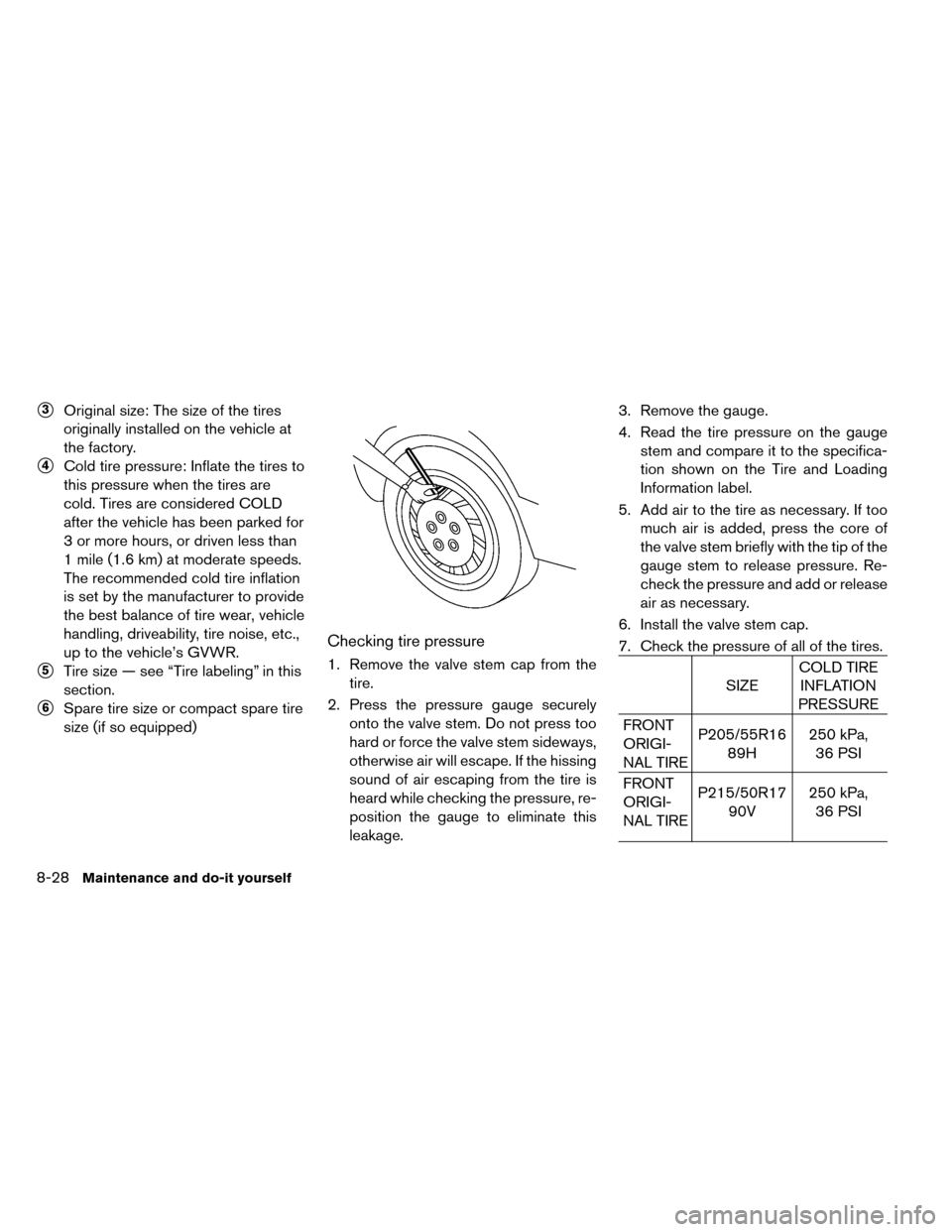Page 319 of 412

• Replacing tires with those not origi-nally specified by NISSAN could affect
the proper operation of the TPMS.
• The Genuine NISSAN Emergency Tire Repair Sealant or equivalent can be
used for temporarily repairing a tire.
Do not inject any other tire liquid or
aerosol tire sealant into the tires, as
this may cause a malfunction of tire
pressure sensors.
• NISSAN recommends using only NISSAN Genuine Emergency Tire Seal-
ant provided with your vehicle. Other
tire sealants may damage the valve
stem seal which can cause the tire to
lose air pressure. Contact a NISSAN
certified LEAF dealer as soon as pos-
sible after using tire repair sealant (for
models equipped with the emergency
tire puncture repair kit) .
REPAIRING FLAT TIRE
WARNING
• After using Emergency Tire Sealant to
repair a minor tire puncture, do not
drive the vehicle at speeds faster than
50 MPH (80 km/h) . •
Immediately after using the Emer-
gency Tire Sealant to repair a minor
tire puncture, take your vehicle to a
NISSAN certified LEAF dealer to in-
spect, and repair or replace the tire.
The Emergency Tire Sealant cannot
permanently seal a punctured tire.
Continuing operation of the vehicle
without a permanent tire repair can
lead to a crash.
• If you used the Emergency Tire Sealant
to repair a minor tire puncture, your
NISSAN certified LEAF dealer will also
need to replace the TPMS sensor in
addition to repairing or replacing the
tire.
• NISSAN recommends using only
NISSAN Genuine Emergency Tire Seal-
ant provided with your vehicle. Other
tire sealants may damage the valve
stem seal which can cause the tire to
lose air pressure.
This vehicle does not have a spare tire. The
emergency tire puncture repair kit (Emergency
Tire Sealant) is supplied with the vehicle instead of a spare tire. It can be used to temporarily repair
minor tire punctures.
If possible, have the vehicle towed to a facility that
can repair or replace the flat tire. Using the emer-
gency tire puncture repair kit may cause a mal-
function of the tire pressure sensor and cause the
low tire pressure warning light to illuminate.
If you have a flat tire, follow the instructions be-
low.
CAUTION
• To avoid the emergency tire puncture
kit being damaged during storage or
use:
–Only use the emergency tire punc-
ture repair kit on your vehicle. Do
not use it on other vehicles.
– Only use the kit to inflate the tires of
your vehicle and to check the vehi-
cle’s tire pressure.
– Only plug the compressor into a 12-
volt DC car power point.
– Keep the kit free of water and dirt.
– Do not disassemble or modify the
kit.
– Do not drop the kit or allow hard
impacts to the kit.
6-4In case of emergency
Page 367 of 412

�3Original size: The size of the tires
originally installed on the vehicle at
the factory.
�4Cold tire pressure: Inflate the tires to
this pressure when the tires are
cold. Tires are considered COLD
after the vehicle has been parked for
3 or more hours, or driven less than
1 mile (1.6 km) at moderate speeds.
The recommended cold tire inflation
is set by the manufacturer to provide
the best balance of tire wear, vehicle
handling, driveability, tire noise, etc.,
up to the vehicle’s GVWR.
�5Tire size — see “Tire labeling” in this
section.
�6Spare tire size or compact spare tire
size (if so equipped)
Checking tire pressure
1. Remove the valve stem cap from thetire.
2. Press the pressure gauge securely onto the valve stem. Do not press too
hard or force the valve stem sideways,
otherwise air will escape. If the hissing
sound of air escaping from the tire is
heard while checking the pressure, re-
position the gauge to eliminate this
leakage. 3. Remove the gauge.
4. Read the tire pressure on the gauge
stem and compare it to the specifica-
tion shown on the Tire and Loading
Information label.
5. Add air to the tire as necessary. If too much air is added, press the core of
the valve stem briefly with the tip of the
gauge stem to release pressure. Re-
check the pressure and add or release
air as necessary.
6. Install the valve stem cap.
7. Check the pressure of all of the tires.
SIZE COLD TIRE
INFLATION
PRESSURE
FRONT
ORIGI-
NAL TIRE P205/55R16
89H 250 kPa,
36 PSI
FRONT
ORIGI-
NAL TIRE P215/50R17
90V 250 kPa,
36 PSI
8-28Maintenance and do-it yourself
Page 374 of 412
EMERGENCY TIRE PUNCTURE
REPAIR KIT
The emergency tire puncture repair kit (Emer-
gency Tire Sealant) is supplied with the vehicle
instead of a spare tire. It can be used to tempo-
rarily repair minor tire punctures.
If possible, have the vehicle towed to a facility that
can repair or replace the flat tire. Using the emer-
gency tire puncture repair kit may cause a mal-
function of the tire pressure sensor and cause the
low tire pressure warning light to illuminate.
See “Flat tire” in the “In case of emergency”
section for more details.
Maintenance and do-it yourself8-35
Page 385 of 412

WARNING
•
It is extremely dangerous to ride
in the cargo area inside the ve-
hicle. In a collision, people riding
in these areas are more likely to
be seriously injured or killed.
•Do not allow people to ride in
any area of your vehicle that is
not equipped with seats and seat
belts.
•Be sure everyone in your vehicle
is in a seat and using a seat belt
properly.
TERMS
It is important to familiarize yourself with
the following terms before loading your
vehicle:
• Curb Weight (actual weight of your ve- hicle) - vehicle weight including: stan-
dard and optional equipment, fluids,
emergency tools, and spare tire assem-
bly. This weight does not
include passen-
gers and cargo.
• GVW (Gross Vehicle Weight) - curb weight plus the combined weight of pas-
sengers and cargo.
• GVWR (Gross Vehicle Weight Rating) - maximum total combined weight of the
unloaded vehicle, passengers, luggage,
hitch, trailer tongue load and any other
optional equipment. This information is
located on the F.M.V.S.S./C.M.V.S.S.
label. • GAWR (Gross Axle Weight Rating) -
maximum weight (load) limit specified
for the front or rear axle. This information
is located on the F.M.V.S.S./C.M.V.S.S.
label.
• GCWR (Gross Combined Weight Rat- ing) - The maximum total weight rating of
the vehicle, passengers, cargo, and
trailer.
• Vehicle Capacity Weight, Load limit, To- tal load capacity - maximum total weight
limit specified of the load (passengers
and cargo) for the vehicle. This is the
maximum combined weight of occu-
pants and cargo that can be loaded into
the vehicle. If the vehicle is used to tow a
trailer, the trailer tongue weight must be
included as part of the cargo load. This
information is located on the Tire and
Loading Information label.
• Cargo capacity - permissible weight of cargo, the subtracted weight of occu-
pants from the load limit.
VEHICLE LOADING INFORMATION
9-10Technical and consumer information